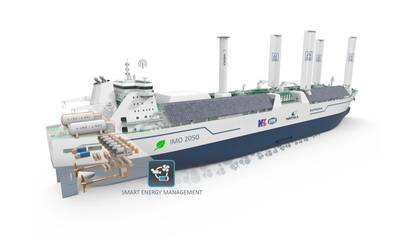ABS, HZS, Wärtsilä Working on 'Future-ready' Multi-fuel Electric LNG Carrier
ABS, Hudong–Zhonghua Shipbuilding (HZS), and Wärtsilä have teamed to develop a flexible, future-ready, and modular concept for a future multi-fuel electric Liquefied Natural Gas Carrier (LNGC) vessel.
The project will, partners say, apply various decarbonization technologies and solutions to the vessel design and operation models to investigate its performance against the International Maritime Organization’s (IMO’s) Carbon Intensity Indicator (CII) up to at least 2050.
"The LNGC will be highly flexible, and the entire vessel design will be optimized around a compact, electrified, integrated and efficient propulsion power solution that will deliver a significant CO2 reduction immediately and be ready to efficiently integrate new technologies in the future in order to stay ahead of the requirements of CII," the three companies said.
"The evolving demands of the CII mean vessels will need to be ready to continuously improve their efficiency rating to remain viable for the duration of their operational life. Advanced multi-physics modeling and simulation techniques enable the development of a vessel with a strong CII profile at launch that is also equipped to take advantage of future decarbonization technologies as they mature,” said Patrick Ryan, ABS Senior Vice President, Global Engineering and Technology.
Song Wei, R&D Deputy Director of Hudong-Zhonghua Shipbuilding: “This state of the art hybrid solution will be developed to power the future LNG carrier, enabling dual-fuel engines running always at best efficiency and providing flexible power supply modes to adapt to various load demands.”
ABS has stressed that shipowners are currently faced with unprecedented challenges and uncertainties as they attempt to plan their fleets in order to meet the IMO’s Carbon Intensity Index (CII) carbon reduction trajectory of -70 percent by 2050.
"What is certain today is that owners must plan now to safeguard a future-proof newbuild vessel design. By installing and optimizing the vessel design around a compact, electrified, and hybridized propulsion system, owners can obtain today a highly optimized and flexible asset that maintains remarkably high efficiency across a broad range of vessel speeds and power nodes – making it highly suitable to accommodate needed vessel speed and voyage optimizations in the future," ABS said.
“The modular and hybridized nature of this smart propulsion system provides the correct foundation for the introduction of new and potentially highly intermittent low-carbon energy sources and propulsion energy-saving devices both in the newbuild phase and also later as potential retrofit solutions. We are honored that ABS and Hudong-Zhonghua have invited us to contribute to the development of this new LNGC design that will leverage ABS’ long experience in LNGC development and simulation expertise as well as Hudong-Zhonghua´s rich design and construction experience of large LNGCs,” said Mr. Stefan Nysjö, Vice President, Power Supply, Wärtsilä Marine Power.














